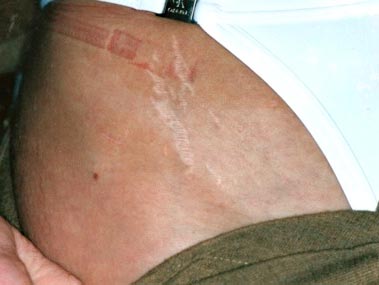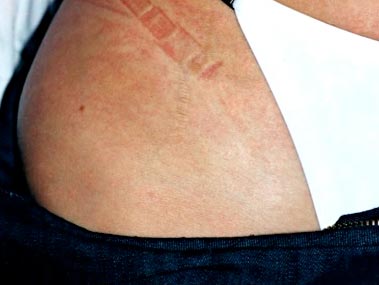Stretch marks (striae) occur when the skin is rapidly stretched or torn resulting in damage to the supportive structures beneath. The microscopic collagen and elastin foundation breaks and reduces in thickness. The thin skin within the stretch mark is more transparent and initially small blood vessels are more visible resulting in red or purple discolouration. Over time these blood vessels contract and the purple colour fades to silver or white.
Stretching of the skin can occur typically in pregnancy or during growth spurts. A large weight gain (over a short period of time) and body building activities can also cause stretch marks to develop. They can appear anywhere on the body but tend to develop mainly in places where large amounts of fat are stored. Thus, they commonly appear on the abdomen and breasts, upper arms, thighs and buttocks.
The use of corticosteroid creams and pills and frequent use of oral steroids have been cited as contributory factors to the development of stretch marks. Certain medical conditions such as Ehlers Danlos Syndrome, Marfan Syndrome and Cushings Syndrome are also linked to their occurance.
Stretch marks do not pose any health risks in themselves. However, they can occasionally (but not always) cause a burning and itching sensation, and they are frequently viewed as unsightly and, therefore, can cause significant emotional distress.

Before

After
Currently, there is no conventional medical treatment for stretch marks.
Pulsed dye lasers have been shown to improve the appearance of unwanted red and purple stretch marks. Energy from the laser is absorbed by blood within the veins under the stretchmark, which collapse and are absorbed. The red or purple colour is usually considerably faded and may disappear altogether. Because pulsed dye lasers are selective, they do not harm surrounding structures resulting in minimal discomfort during treatment and rapid return to normal daily activities.
Fractional lasers have been shown to be highly effective in the treatment of older white or silver stretch marks.
The fractional Er Yag 2940nm laser utilises a matrix of microscopic laser beams measuring 300um (0.3mm) in diameter to drill into the stretchmark leaving much of the surrounding skin undisturbed. These spared areas contain undamaged cells that are able to migrate swiftly into the treated area and promote rapid healing. The stimulation of a healing response produces collagen that forms a new foundation supporting the stretchmark and smoothing out the surface furrows. In addition to this ablative effect, there is a ‘tightening’ of the collateral collagen fibres pulling the sides of the stretch mark closer together.
Our expert medical team has in excess of 30 years laser experience and have completed more than 150,000 successful treatments. Rest assured you are in safe hands. All procedures at our Cambridge Laser Clinic are performed by fully qualified doctors, nurses and practitioners.
To ensure the highest ethical standards are maintained at all times, our staff are never offered bonus incentives to sell treatments.
Although medical laser clinics are no longer regulated by the CQC (Care Quality Commission), we continue to adhere to the strict standards that were in the past mandatory under government legislation. This is the best indicator currently available that our Cambridge Laser Clinic is trustworthy.
All consultations are free of charge so why not call our team of experts today?
